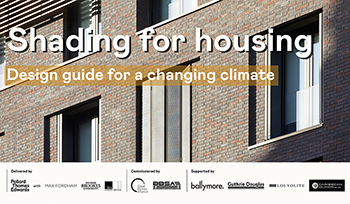Dehumidification
Contents |
[edit] Introduction
Absolute humidity is the mass of water vapour in a volume of air divided by the mass of dry air. Relative humidity (RH) is a measure of the water vapour density of air compared to the water vapour density for saturated air at the same temperature and pressure (that is, the maximum amount of moisture that air can 'hold' at that temperature and pressure).
Humidity in buildings is regulated by Approved Document C (Site preparation and resistance to contaminates and moisture) and Approved Document F (Ventilation) and further guidance is available in BS 5250 Code of practice for the control of condensation in buildings.
[edit] Issues associated with excessive humidity
RH is expressed as a percentage. Typically, a relative humidity of 40% to 60% is appropriate in many buildings.
In addition to creating an unpleasant, musty smell, too much humidity in the air can be detrimental to health and can influence thermal comfort. The higher the relative humidity, the less heat a person is able to lose through the evaporation of moisture on the skin, and so the hotter they will feel.
High humidity levels can sometimes affect the performance of buildings, resulting in slip hazards, staining and growth of mould, mildew and fungus on walls and ceilings. If excessive condensation occurs, this can sometimes damage equipment and contribute to the corrosion and decay of the building fabric as well as poor performance of insulation.
For more information, see Condensation.
Excessive moisture is sometimes associated with rising and penetrating damp, which can be expensive and complicated to eradicate completely.
For more information, see Rising damp
[edit] How dehumidification reduces moisture
Humidity can be controlled by limiting sources of moisture, increasing ventilation or removing it through a process referred to as dehumidification. Dehumidification uses a device known as a dehumidifier to remove moisture from the warm, humid air before the air comes into contact with a cold surface, condenses and deposits the moisture onto the cold surface.
The dehumidification process is based on the refrigeration principles that gas under pressure heats up and when the pressure drops, so does the temperature of the gas. In a dehumidifier, a compressor delivers pressurised gas to the ‘hot’ coils, in turn, leading to the larger ‘cold’ coils, which allow the gas to expand. The cooled gas returns to the compressor for recycling.
This is achieved by drawing air from the room into the unit and passing it over cold coils upon which water vapour condenses and drips into a reservoir. The cold, but now dry air is drawn by a fan over heated coils before being returned to the room as additional convected heat.
A device called a humidistat switches off the compressor when the humidity (moisture content) of the surrounding air has dropped to the required level.
For more information, see Humidistat
[edit] Types of dehumidifiers
When installed in a damp room, a dehumidifier can extract excess moisture from the furnishings and fabric of the building in a week or two. After that, it will monitor the moisture content of the air to maintain a stabilised atmosphere. A portable version of a dehumidifier can be wheeled from room to room, where it is plugged into a standard wall socket.
Dehumidifiers use different methods to remove moisture from the air. Common examples include:
- Thermal condensation dehumidification.
- Absorption or desiccant dehumidification.
- Ionic membrane dehumidification.
In some instances, dehumidification may take place in conjunction with temperature control associated with air conditioning and heating equipment.
[edit] Dehumidification, cooling and heating
The process of dehumidification and cooling can be achieved when the air at the given dry bulb (DB) and dew point (DP) temperatures is cooled below the DP temperature. The cooling and dehumidification process is commonly incorporated into different types of air conditioning applications.
Heating and dehumidification is used in situations where it is necessary to reduce the DP temperature of the air. The heating and dehumidification process helps to minimise the chance of corrosion that could damage certain types of sensitive equipment or lead to faulty operation.
[edit] Related articles on Designing Buildings
- Air conditioning.
- Basement waterproofing.
- Chilled water.
- Condensation.
- Cooling systems for buildings.
- Crawl space.
- Desiccant cooling.
- Dew point.
- Dry-bulb temperature.
- Heating ventilation and air conditioning HVAC.
- Humidification.
- Humidistat.
- Humidity.
- Mechanical ventilation of buildings.
- Rising damp.
- Water vapour in the built environment.
Featured articles and news
Editor's broadbrush view on forms of electrical heating in context.
The pace of heating change; BSRIA market intelligence
Electric Dreams, Boiler Realities.
New President of ECA announced
Ruth Devine MBE becomes the 112th President of the Electrical Contractors Association.
New CIAT Professional Standards Competency Framework
Supercedes the 2019 Professional Standards Framework from 1 May 2025.
Difficult Sites: Architecture Against the Odds
Free exhibition at the RIBA Architecture Gallery until 31 May.
PPN 021: Payment Spot Checks in Public Sub-Contracts
Published following consultation and influence from ECA.
Designing Buildings reaches 20,000 articles
We take a look back at some of the stranger contributions.
Lessons learned from other industries.
The Buildings of the Malting Industry. Book review.
Conserving places with climate resilience in mind.
Combating burnout.
The 5 elements of seiri, seiton, seiso, seiketsu and shitsuke.
Shading for housing, a design guide
A look back at embedding a new culture of shading.
The Architectural Technology Awards
The AT Awards 2025 are open for entries!
ECA Blueprint for Electrification
The 'mosaic of interconnected challenges' and how to deliver the UK’s Transition to Clean Power.
Grenfell Tower Principal Contractor Award notice
Tower repair and maintenance contractor announced as demolition contractor.























